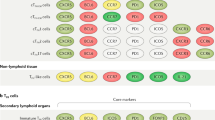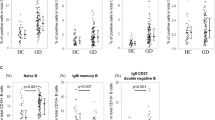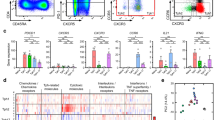Abstract
Autoinflammatory attacks in familial Mediterranean fever (FMF) are accompanied by elevated levels of interleukin-6 (IL-6), and are controllable by IL-1-targeting drugs. In combination, IL-6 and IL-1 are known to be potent inducers of T helper (Th) 17 cells development. Therefore, we studied the Th17 population size, and activation potential, of FMF patients. Based on the relative mRNA expression of the Th1, Th2, Treg and Th17 transcription factors T-bet, GATA3, FOXP3 and retinoic acid-related orphan receptor γT (RORγT), respectively, the Th17 population in peripheral blood mononuclear cells (PBMCs) of healthy subjects was estimated at 2.5% of the entire Th population and 4.4% in FMF patients in remission (n=6 for each group, P=0.03). IL-17 secretion after universal stimulation of the T-cell receptor in PBMCs culture was twice higher in cultures of patients with frequent attacks (n=18) than in those of patients with infrequent attacks (n=10, 1124±266 vs 615±196 pg ml−1, P=0.009). IL-17 secretion correlated well with IL17A mRNA level. Part of the increased secretion was related to the deleterious, MEFV p.M694V homozygous genotype (n=19, 1.5-fold, P=0.03). Almost all IL-17 producer cells were CD4-positive (CD4+IL-17+). In conclusion, frequent attacks and the deleterious FMF genotype appear to drive FMF patients to a heightened Th17 response.
This is a preview of subscription content, access via your institution
Access options
Subscribe to this journal
Receive 6 digital issues and online access to articles
$119.00 per year
only $19.83 per issue
Buy this article
- Purchase on Springer Link
- Instant access to full article PDF
Prices may be subject to local taxes which are calculated during checkout



Similar content being viewed by others
References
Lidar M, Livneh A . Familial Mediterranean fever: clinical, molecular and management advancements. Neth J Med 2007; 65: 318–324.
Gang N, Drenth JP, Langevitz P, Zemer D, Brezniak N, Pras M et al. Activation of the cytokine network in familial Mediterranean fever. J Rheumatol 1999; 26: 890–897.
Baykal Y, Saglam K, Taslipinar A, Inal A . Serum sIL-2r, IL-6, IL-10 and TNF-alpha level in familial Mediterranean fever patients. Clin Rheumatol 2003; 22: 99–101.
Oktem S, Yavuzsen TU, Sengül B, Akhunlar H, Akar S, Tunca M . Levels of interleukin-6 (IL-6) and its soluble receptor (sIL-6R) in familial Mediterranean fever (FMF) patients and their first degree relatives. Clin Exp Rheumatol 2004; 22 (Suppl 34): 34–36.
Meinzer U, Quartier P, Alexandra JF, Hentgen V, Retornaz F, Koné-Paut I . Interleukin-1 targeting drugs in familial Mediterranean fever: a case series and a review of the literature. Semin Arthritis Rheum 2011; 41: 265–271.
Chae JJ, Aksentijevich I, Kastner DL . Advances in the understanding of familial Mediterranean fever and possibilities for targeted therapy. Br J Haematol 2009; 146: 467–478.
Zielinski CE, Mele F, Aschenbrenner D, Jarrossay D, Ronchi F, Gattorno M et al. Pathogen-induced human TH17 cells produce IFN-γ or IL-10 and are regulated by IL-1β. Nature 2012; 484: 514–518.
Acosta-Rodriguez EV, Napolitani G, Lanzavecchia A, Sallusto F . Interleukins 1beta and 6 but not transforming growth factor-beta are essential for the differentiation of interleukin 17-producing human T helper cells. Nat Immunol 2007; 8: 942–949.
Roussel L, Houle F, Chan C, Yao Y, Bérubé J, Olivenstein R et al. IL-17 promotes p38 MAPK-dependent endothelial activation enhancing neutrophil recruitment to sites of inflammation. J Immunol 2010; 184: 4531–4537.
Ivanov II, McKenzie BS, Zhou L, Tadokoro CE, Lepelley A, Lafaille JJ et al. The orphan nuclear receptor RORgammat directs the differentiation program of proinflammatory IL-17+ T helper cells. Cell 2006; 126: 1121–1133.
Liang SC, Long AJ, Bennett F, Whitters MJ, Karim R, Collins M et al. An IL-17F/A heterodimer protein is produced by mouse Th17 cells and induces airway neutrophil recruitment. J Immunol 2007; 179: 7791–7799.
Haznedaroglu S, Oztürk MA, Sancak B, Goker B, Onat AM, Bukan N et al. Serum interleukin 17 and interleukin 18 levels in familial Mediterranean fever. Clin Exp Rheumatol 2005; 23 (Suppl 38): 77–80.
Manukyan GP, Ghazaryan KA, ZhA Ktsoyan, Tatyan MV, Khachatryan ZA, Hakobyan GS et al. Cytokine profile of Armenian patients with Familial Mediterranean fever. Clin Biochem 2008; 41: 920–922.
Manukyan G, Ghazaryan K, Ktsoyan Z, Khachatryan Z, Kelly D, Tatyan M et al. Comparative analysis of cytokine profiles in autoinflammatory and autoimmune conditions. Cytokine 2010; 50: 146–151.
Shinar Y, Livneh A, Langevitz P, Zaks N, Aksentijevich I, Koziol DE et al. Genotype-phenotype assessment of common genotypes among patients with familial Mediterranean fever. J Rheumatol 2000; 27: 1703–1707.
Sutton CE, Lalor SJ, Sweeney CM, Brereton CF, Lavelle EC et al. Interleukin-1 and IL-23 induce innate IL-17 production from γδ T cells, amplifying Th17 responses and autoimmunity. Immunity 2009; 31: 331–341.
Perry JSA, Han S, Xu Q, Herman ML, Kennedy LB, Csako G et al. Inhibition of LTi cell development by CD25 blockade is associated with decreased intrathecal inflammation in multiple sclerosis. Sci Trans Med 2012; 4: 145ra106.
Hoffman HM, Mueller JL, Broide DH, Wanderer AA, Kolodner RD . Mutation of a new gene encoding a putative pyrin-like protein causes familial cold autoinflammatory syndrome and Muckle-Wells syndrome. Nat Genet 2001; 29: 301–305.
Meng G, Zhang F, Fuss I, Kitani A, Strober W . A mutation in the Nlrp3 gene causing inflammasome hyperactivation potentiates Th17 cell-dominant immune responses. Immunity 2009; 30: 860–874.
Brydges SD, Mueller JL, McGeouGh MD, Pena CA, Misaghi A, Gandhi C et al. Inflammasome-mediated disease animal models reveal roles for innate but not adaptive immunity. Immunity 2009; 30: 875–887.
Lasigliè D, Traggiai E, Federici S, Alessio M, Buoncompagni A, Accogli A et al. Role of IL-1 beta in the development of human T(H)17 cells: lesson from NLPR3 mutated patients. PLoS One 2011; 6: e20014.
Puel A, Cypowyj S, Bustamante J, Wright JF, Liu L, Lim HK . Chronic mucocutaneous candidiasis in humans with inborn errors of interleukin-17 immunity. Science 2011; 332: 65–68.
Chamilos G, Ganguly D, Lande R, Gregorio J, Meller S, Goldman WE et al. Generation of IL-23 producing dendritic cells (DCs) by airborne fungi regulates fungal pathogenicity via the Induction of TH-17 responses. PLoS One 2010; 5: e12955.
Shinar Y, Livneh A, Villa Y, Pinhasov A, Zeitoun I, Kogan A et al. Common mutations in the familial Mediterranean fever gene associate with rapid progression to disability in non-Ashkenazi Jewish multiple sclerosis patients. Genes Immun 2003; 4: 197–203.
Rabinovich E, Livneh A, Langevitz P, Brezniak N, Shinar E, Pras M et al. Severe disease in patients with rheumatoid arthritis carrying a mutation in the Mediterranean fever gene. Ann Rheum Dis 2005; 64: 1009–1014.
Yahalom G, Kivity S, Lidar M, Vaknin-Dembinsky A, Karussis D, Flechter S et al. Familial Mediterranean fever (FMF) and multiple sclerosis: an association study in one of the world's largest FMF cohorts. Eur J Neurol 2011; 18: 1146–1150.
Hemdan NY, Birkenmeier G, Wichmann G, Abu El-Saad AM, Krieger T, Conrad K et al. Interleukin-17-producing T helper cells in autoimmunity. Autoimmun Rev 2010; 9: 785–792.
Livneh A, Langevitz P, Zemer D, Zaks N, Kees S, Lidar T et al. Criteria for the diagnosis of familial Mediterranean fever. Arthritis Rheum 1997; 40: 1879–1885.
Dheda K, Huggett JF, Bustin SA, Johnson MA, Rook G, Zumla A . Validation of housekeeping genes for normalizing RNA expression in real-time PCR. Bio Techniques 2004; 37: 112–119.
Livak KJ, Schmittgen TD . Analysis of relative gene expression data using real-time quantitative PCR and the 2(-Delta Delta C(T)) Method. Methods 2001; 25: 402–408.
Acknowledgements
We thank Dr Itamar Goldstein for invaluable discussions. This study was supported by a grant devoted to the memory of Johana Feler and her family members who perished in the Holocaust.
Author information
Authors and Affiliations
Corresponding author
Ethics declarations
Competing interests
The authors declare no conflict of interest.
Rights and permissions
About this article
Cite this article
Ovadia, A., Livneh, A., Feld, O. et al. T helper 17 polarization in familial Mediterranean fever. Genes Immun 14, 212–216 (2013). https://doi.org/10.1038/gene.2013.6
Received:
Revised:
Accepted:
Published:
Issue Date:
DOI: https://doi.org/10.1038/gene.2013.6
Keywords
This article is cited by
-
Neuromyelitis optica spectrum disorder with a familial Mediterranean fever gene E84K mutation
Journal of Neurology (2023)
-
SAPHO Syndrome: Current Developments and Approaches to Clinical Treatment
Current Rheumatology Reports (2016)



